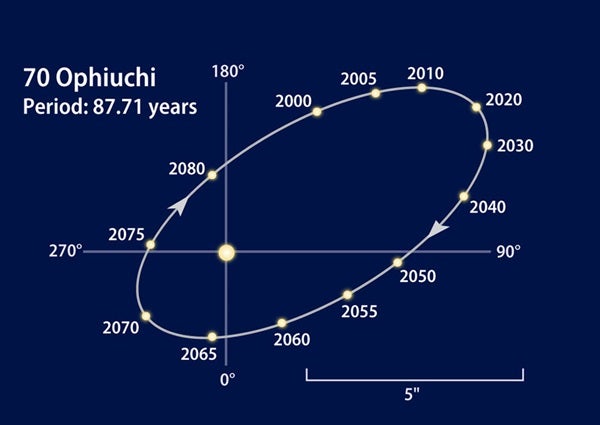That’s a tall order. Of the thousands of double stars resolvable in small- to medium-sized telescopes, true binary pairs with orbital periods of 20 years or less are as rare as astronomers at an astrology convention. An unfortunate astronomical fact of life is that the typical short-period binary comprises stars locked in a close gravitational embrace. The result is a sub-arcsecond angular separation that observers can breach only using large-aperture telescopes. Conversely, a binary star with a wide angular separation is likely composed of physically distant components whose orbital period is measured in centuries.
Twenty years may be a stretch, but a number of visual binaries undergo a large portion of their orbits well within the span of a human lifetime. Using nothing more than my trusted 3-inch f/10 reflecting telescope, I’ve followed the orbital shift of a trio of binary stars.
The first is Alpha (α) Geminorum, better known as Castor. Attempting to split this magnitude 1.9 and 2.9 pair in 1970 proved marginally successful. At the time, the two were separated by 1.8″ — as close to one another as they can get (an orbital position called “periastron”). Six years later, they had widened enough (2.1″) to be cleanly split at 120x. At present, half that magnification will reveal both components, now separated by a comfortable 5.0″. They will remain an easy small-scope target until their next periastron sometime during the 25th century.
Porrima (Gamma [γ] Virginis) presented the opposite set of circumstances. In 1970, this striking set of magnitude 3.5 twins was 4.6″ apart — a piece of cake for the 3-inch scope. They were closing rapidly, however, and by the beginning of this century were resolvable only through large telescopes. At periastron in 2005, they were a mere 0.4″ apart. The two are now separating, and their current 1.7″ gap will more than double in the next 20 years.
70 Ophiuchi vividly demonstrates this high-gear orbital shift at periastron. When I first observed 70 Ophiuchi in 1970, its component stars were separated by 2.4″. Back then, the 5.9-magnitude companion was situated northeast of the magnitude 4.2 primary. Approaching periastron, the companion picked up speed. In less than half of its roughly 88-year cycle, it arced north, west, and south to its present location 6.0″ southwest of the primary — an orbital swing of 270°! Now approaching “apastron” (greatest separation), the companion is slowing down. A half-century will pass before it completes the final 90° segment of its orbit.
Perhaps you’re not interested in spending 20 to 30 years monitoring the orbital activity of a binary star. How about spending 20 to 30 minutes admiring what is undoubtedly one of the night sky’s premium double stars? 70 Ophiuchi is part of a “mini Hyades” — a V-shaped asterism in Ophiuchus called “the Bull of Poniatowski.” Composed of K-type dwarfs, 70 Ophiuchi sports colors of golden yellow and orange-red. A few reputable astronomers claim that the companion is violet! Take a good look at 70 Ophiuchi and see if you agree.
70 Ophiuchi has pretty much “done its orbital thing.” A frenetic periastron sprint has evolved into a casual apastron stroll. Backyard astronomers eager to document a rapid orbital change in a binary star will have to look elsewhere. Next spring, I’ll introduce you to another easily observed, rapidly orbiting binary. Stay tuned!
Psst! Looking for a useful astronomical website to visit on cloudy nights? Try “The Constellations,” a site put together by Richard Dibon-Smith, author of the star atlas StarList 2000 (John Wiley & Sons, 1992). As you explore its many useful items, you’ll come across a section containing detailed diagrams of the orbits of 70 Ophiuchi and dozens of other binary stars. Check it out at www.dibonsmith.com/orbits.htm.
Questions, comments, or suggestions? E-mail gchaple@hotmail.com. Next month: A tale of two (star) cities. Clear skies!











